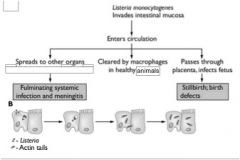![]()
![]()
![]()
Use LEFT and RIGHT arrow keys to navigate between flashcards;
Use UP and DOWN arrow keys to flip the card;
H to show hint;
A reads text to speech;
22 Cards in this Set
- Front
- Back
|
Is erysipelothrix gram +/-?
What industry is this a problem in? What are the virulence factors? |
Gram positive short rod!
•! Swine and poultry Problems! •! Virulence factors! –! _capsule__! –! Surface proteins! –! Extracellular proteins! •! Neuraminidase! •! Others (?)! Acute Erysipelas! |
|
|
What kind of lesion does erysiphelothrix cause in pigs?
|
classic diamond lesion
Severity of lesion can indicate severity of disease |
|
|
Can erysipelothrix be vaccinated against?
|
•! ___passive antibody__ can eliminate
disease- thus humoral immunity is likely important! |
|
|
What does erysepilothrix capsule use to protect it?
|
E. r. produces a capsule that
protects against killing by __phagocytosis__.! However, encapsulated bacteria can survive and grow within phagocytes.! |
|
|
how many erysepilothrix serotypes are there? Are vaccines available?
|
There are over 25 serotypes, however types 1 and 2 are the
most common Infection through breaks in the skin- at lamb marking or dipping, or via the umbilicus in newborns. Good hygiene important. __Vaccines__ are available.! |
|
|
What are possible phases of erysepilothrix?
|
Possible phases of the disease
" __Peracute___" • Pig found dead with no clinical signs" • #The disease starts with a sudden onset." Acute#" High temperature (40-42C). " Often found lying down- when encourage to " "rise will rapidly lie again. " Often off their feed. " Sows may abort with the high temperature. " Boars may become permanently or temporarily infertile." 2 to 3 days after initially becoming infected pigs develop diamond skin lesions which can be pink to dark purple. The lesions are generally raised which may be the only way to diagnose the disease in black pigs. May go necrotic." |
|
|
What are the two types of chronic disease of erysepilothrix?
|
arthritis and
endocarditis" "Endocarditis" •! Damage to heart valves (cauliflower valves)" "- leads to circulatory probs." •! Poor circulation especially after exertion. " •! Extremities may turn purple from poor circulation" "Arthritis" •! 3 weeks after infection the pig may present " "with a chronic lameness in one or two joints. ! Pathogen is commonly not _culturable_ in chronic disease." |
|
|
How are pigs infected by erysepilothrix?
|
Many pigs (20-50%) carry the organism on their_tonsils_
without any clinical signs. " Soil, bedding, feces and drinking water can become contaminated." _Stressed_ pigs are more likely to show clinical signs, cases are more likely after pigs have become stressed " -! sudden changes in diet" -! sudden changes in temperature" -! introduction of other diseases (I.e. Swine Influenza) " The organism can cause problems in turkeys which can then cross-infect pigs. " The organism also lives in fish and fish meal can be an " infection source." |
|
|
Is erysipelothrix zoonotic?
|
Humans can get erysipeloid-
occupational infections from people who work with infected animals or tissues." Note: not human erysipelas-" Human streptococcal infection. Symptoms similar. |
|
|
What are the three species of listeria?
Are they gram +? |
•! Three species, one major pathogen.!
–! Listeria monocytogenes: humans and animals! –! L. ivanovii: probs. in ruminants, not humans ! –! L. innocua! •! Gram positive, nonsporeforming, motile,! –! Catalase positive, oxidative, facultative anaerobe! |
|
|
Other than pigs and humans, how does erysipelothrix infect other species?
|
Birds- septicemia. Primarily _________. Can
lead to high mortality. Poultry erysipelas- Septicemia, swollen snoods, acute disease." Sheep- polyarthritis associated with wound-borne pathogens. Can also get septicemia - castration, docking and shearing wounds. Pathogen of marine mammals! •! Can cause fatal disease! •! Erysipelothrix in fish may be source of infection of marine mammals.! |
|
|
What are the three main diseases caused by Listeria?
How is diagnosis achieved? |
•! __abortion__ in several species!
•! __septicemia__- active bacteria in bloodstream! •! __encephalitis__- other neural infections! –! Meningoencephalitis (circling disease)! Specializes in crossing barriers it shouldn't (BBB) •! Diagnosis often begins with an association w/ feeding _silage__.! •! One of the CLEARs- G+ short rods.! |
|
|
How does Listeria spread cell to cell?
Where does Listeria live in the cell? |

___acid__-based cell-to-cell spread by Listeria!
If you knock out any of these steps, you stop the organism. It lives in the cytoplasm of the cell |
|
|
What role does actin play in getting Listeria from cell to cell?
What happens when it gets into the second cell? |
Listeria lives in the cytoplasm, propelled by actin, it travels straight across the barriers, that's how it crosses BBB and other protective membranes.
Works by Dividing bacteria accumulate actin at one end ! A secondary vacuole resulting from being driven out a protrusion and into a second cell. |
|
|
What is ActA?
|
Actin polymerization: a single bacterial protein (ActA)
nucleates a collection of host proteins.! It's what Listeria uses to propel itself across membranes. |
|
|
What are the steps in Listeria infection?
|

see pic
|
|
|
What is the progression of listeria infection?
|
Generally __food borne__
– Penetrate intestine- M cells – Systemic spread – Pathogen can cross placenta • May infect through breaks in _oral/nasal mucosa__-traffic to cranial nerves- neural disease |
|
|
What kind of pathogen is Listeria? What pH level suits it?
What are the immune processes dependent on? |
Facultative intracellular pathogen, intracellular biology is essential for pathogenesis.
•ALL relevant immune processes are _CD8__-dependent. Environmental pathogen- can grow to high levels in silage above pH 5.5 |
|
|
What is the connection between Listeria and silage?
|
Listeria infections in ruminants often
come from improperly _stored_ silage. |
|
|
What are the forms of listeriosis in ruminants?
|
–! meningoencephalitis!
–! most common form = __circling__ disease (ruminants) ! •! animal circles in one direction only! •! unilateral facial paralysis, difficulty in swallowing! •! fever, blindness, headpressing! •! paralysis, death in 2 - 3 days! |
|
|
What temperature range suits Listeria?
|
Listeria can grow over a very large temperature range!
** pathogen can grow in the refrigerator!! Human disease: ! •! Disease of low occurrence, relatively high __mortality__.! •! Often associated with refrigerated raw dairy products, raw vegetables, cole slaw.! •! ___pregnant_ women, immunocompromised = biggest problems.! |
|
|
What is the specific potential harm to vets that Listeria may cause?
|
* Use hard cheeses, like cheddar, instead of soft cheeses during !
!pregnancy.! * If you do use soft cheeses during pregnancy, cook them until they ! !are boiling (bubbling).! * Use only pasteurized dairy products. ! * Eat only thoroughly cooked meat, poultry or seafood.! * Thoroughly reheat all meats purchased at deli counters.! * Wash all fruits and vegetables with water.! * Follow label instructions on products that must be refrigerated or ! !that have a "use by" date.! * Keep the inside of the refrigerator, counter tops, and utensils clean.! * After handling raw foods, wash your hands with warm soapy water, !and wash the utensil you used with hot soapy water before using ! !them again.! Precautions to avoid human Listeria infections:! Vets: Be careful with bovine abortion products and septicemia cases. ! |

